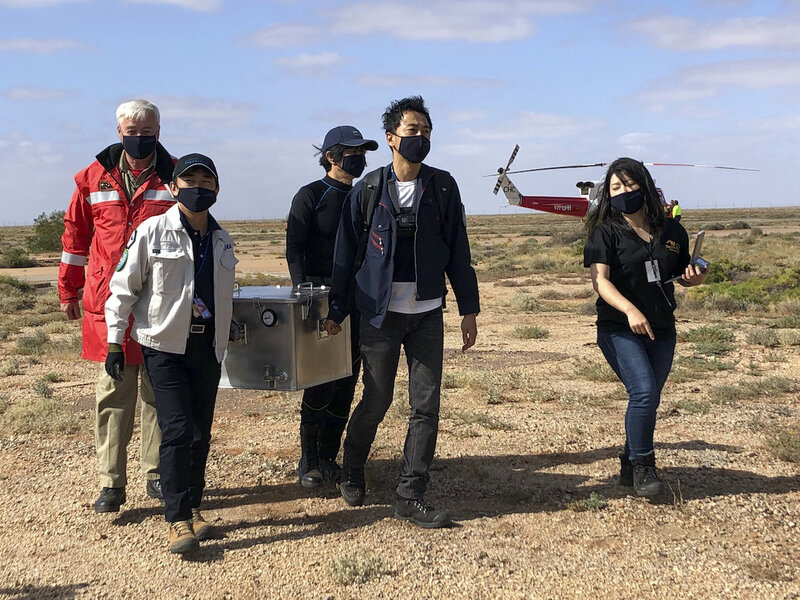Asteroid samples: Japanese space capsule brings ‘treasure box’ to Earth
Loading...
| Tokyo
A small capsule containing asteroid soil samples that was dropped from 136,700 miles in space by Japan’s Hayabusa2 spacecraft landed as planned in the Australian Outback on Sunday. The capsule’s delivery completes a six-year sample-return mission and opens the door for research into finding clues to the origin of the solar system and life on Earth.
After a preliminary inspection, it will be flown to Japan for research. The extremely high precision required to carry out the mission thrilled many in Japan, who said they took pride in its success. The project’s manager, Yuichi Tsuda, of the Japan Aerospace Exploration Agency (JAXA), called the capsule a “treasure box.”
What is the Hayabusa2 mission?
Launched on Dec. 3, 2014, the unmanned Hayabusa2 spacecraft touched down twice on the asteroid Ryugu, 190 million miles away from Earth. The asteroid’s extremely rocky surface forced the mission’s team to revise landing plans, but the spacecraft successfully collected data and soil samples during the year and a half it spent near Ryugu after arriving there in June 2018.
In its first touchdown in February 2019, the spacecraft collected surface dust samples, similar to NASA’s recent touch-and-go grab by Osiris REx on the asteroid Bennu. Hayabusa2 later blasted a crater into the asteroid’s surface and then collected underground samples from the asteroid, a first for space history. In late 2019, Hayabusa2 left Ryugu. That yearlong journey ended Sunday.
Japan hopes to use the expertise and technology used in the Hayabusa2 in the future, perhaps in its 2024 MMX sample-return mission to a Martian moon.
Why an asteroid?
Asteroids orbit the sun but are much smaller than planets. They are among the oldest objects in the solar system and therefore may contain clues into how Earth evolved. Scientists say that requires studying samples from such celestial objects.
Ryugu in Japanese means “Dragon Palace,” the name of a sea-bottom castle in a Japanese folk tale.
Japan’s research into asteroids also may contribute to resource development and to finding ways to protect Earth from collisions with big meteorites, said Hitoshi Kuninaka, JAXA’s vice president.
What’s inside the capsule?
The pan-shaped capsule, about 15 inches in diameter, contains soil samples taken from two different sites on the asteroid. Some gases might also be embedded in the samples. The preliminary inspection at a lab in Australia was to extract and analyze the gas. The capsule is due to return to Japan on Tuesday. It will be taken to JAXA’s research center in Sagamihara, near Tokyo.
What can asteroid samples tell us?
Scientists say the samples, especially ones taken from under the asteroid’s surface, contain data from 4.6 billion years ago unaffected by space radiation and other environmental factors. They are particularly interested in studying organic materials in the samples to learn about how they are distributed in the solar system and if or how they are related to life on Earth. JAXA President Hiroshi Yamakawa said he believes analysis of the samples may help explain the origins of the solar system and how water helped to bring life to Earth. Fragments brought back from Ryugu can also tell its collision and thermal history.
After about a year, some of the samples will be shared with NASA and other international scientists. About 40% of them will be stored for future research. JAXA mission manager Makoto Yoshikawa said just 0.1 gram of the sample can be enough to conduct the planned research, though he said more would be better.
Why is Hayabusa2 such a big deal for Japan?
Hayabusa2 is a successor of the original Hayabusa mission that Japan launched in 2003. After a series of technical setbacks, it sent back samples from another asteroid, Itokawa, in 2010. The spacecraft was burned up in a failed re-entry but the capsule made it to Earth.
Many Japanese were impressed by the first Hayabusa spaceship’s return, which was considered a miracle given all the troubles it encountered. JAXA’s subsequent Venus and Mars missions also were flawed. Mr. Tsuda said the Hayabusa2 team used all the hard lessons learned from the earlier missions to accomplish a 100 times better than “perfect” outcome. Some members of the public who watched the event shed tears as the capsule successfully entered the atmosphere, briefly flaring into a fireball.
What’s next?
About an hour after separating from the capsule at 136,700 miles from Earth, Hayabusa2 was sent on another mission to the smaller asteroid, 1998KY26. That is an 11-year journey one-way. The mission is to study possible ways to prevent big meteorites from colliding with Earth.
This story was reported by The Associated Press.







